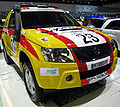2007 Suzuki Grand Vitara Owner's Manual - Page 124
2007 Suzuki Grand Vitara Manual
Page 124 highlights
DRIVING TIPS Don't Make Sharp Turns As mentioned before, small multipurpose vehicles have specific design characteristics that allow them to perform in a wide variety of applications. These characteristics also change the cornering behavior relative to conventional passenger cars. Remember, small multipurpose vehicles have more responsive steering and a higher center of gravity than conventional passenger cars. If at all possible, avoid making sharp turns in your vehicle. Slow Down on Curves Learn to approach curves cautiously and at a conservative speed. Do not attempt to take curves at the same speeds that you would in a vehicle with a lower center of gravity. Just as you would not drive a sports car on a trail, you should not attempt to drive your vehicle around curves like a sports car. Slow Down and Use Caution on Slippery Roads Under wet road conditions you should drive at a lower speed than on dry roads due to possible slippage of tires during braking. When driving on icy, snowcovered or muddy roads, reduce your speed and avoid sudden acceleration, abrupt braking or sharp steering movements. Use 4-wheel drive high range (4H) (if equipped) for better traction. CAUTION Do not operate your vehicle in "4H LOCK" or "4L LOCK" on dry, hard surfaces. Operating your vehicle in "4H LOCK" or "4L LOCK" on dry, hard surfaces puts severe stress to the drive train, especially during tight cornering, and can damage it. Also, you may have some difficulty steering. NOTE: Avoid operating your vehicle in "4H LOCK" or "4L LOCK" on wet pavement as much as possible. Operating your vehicle in "4H LOCK" or "4L LOCK" on wet pavement may cause severe damage to the drive train. NOTE: Operating your vehicle in "4H" on dry and tight corner may cause some vibration on your vehicle. This is not caused by the vehicle malfunction, but caused by working of the limited slip differential gear in the center differential. CAUTION Unevenly worn tires can cause problems in the operation of the transfer switch. Be sure to rotate the tires according to the maintenance schedule. Refer to "Tires" and "Maintenance Schedule" in the "INSPECTION AND MAINTENANCE" section for proper tire rotation procedures. 7-3
















